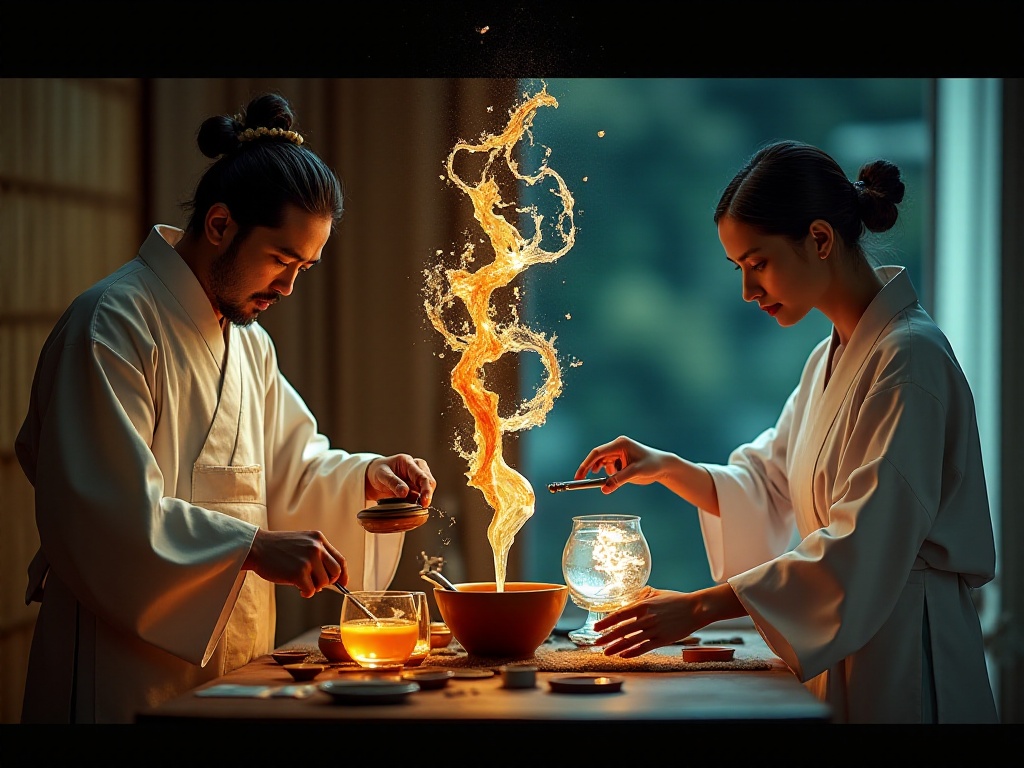The Science of Ice Cubes
When it comes to making beverages, ice cubes are truly an art form. As a beverage enthusiast, I'm often asked various questions about ice by my friends. The most common one is: "Why do some bars use large ice spheres while others use crushed ice? What's the difference?"
Large ice spheres are like time bombs in the beverage world, melting extremely slowly, which helps maintain the drink's original flavor. Imagine spending half a month's living expenses on a premium whiskey, only to have it taste like whiskey-flavored water because the ice melted too quickly - that would be devastating. Large ice spheres solve this problem, not only allowing you to slowly savor the spirit's essence but also providing a beautifully transparent and rounded visual element. I once watched a bartender in Tokyo craft ice spheres live using specialized tools, and their concentration was truly impressive.
As for crushed ice, it's like the vanguard of the beverage world. In summer, everyone loves ordering a mojito full of crushed ice - it not only provides quick cooling but also makes the mint's refreshing taste explode immediately. However, here's a reminder: while crushed ice cools efficiently, it melts very quickly, so you need to drink relatively fast; otherwise, after chatting with friends, you'll find only water left in your glass.
Pellet ice is my personal favorite, with an incredible texture like chewing snow. Many chain coffee shops use this type of ice in their frappuccinos because it makes beverages especially smooth. I remember feeling like I'd discovered a new world when I first tried pellet ice. Its production process is also interesting, requiring special ice machines that use high pressure to turn water into tiny ice particles.
Ice cube shapes also matter. Square ice cubes are suitable for whiskey or other spirits because their relatively small surface area means they melt slower. Long rectangular ice cubes are better suited for Collins glasses, not only looking elegant but also maintaining an even temperature throughout the drink.
Choosing the Right Ice
Selecting appropriate ice is truly a science. For whiskey, large ice spheres are definitely the wise choice. I have a friend who loves whiskey so much that he bought a special ice sphere mold for his home, preparing ice spheres a day in advance just to perfectly taste the whiskey's flavors.
For cocktails like mojitos or margaritas, crushed ice is the better option. These drinks need sufficient dilution and rapid cooling to perfectly blend their various ingredients' flavors. When I make mojitos at home, I crush regular ice cubes in a blender, which works quite well.
Temperature control is an important factor when choosing ice. Different beverages have their optimal drinking temperatures. For example, some cocktails taste best at around -2°C, which requires selecting appropriate ice to achieve this temperature. During my research at a boutique bar, I noticed they used professional thermometers to measure drink temperatures, ensuring each drink was served to customers in its optimal state.
Ice quality is also crucial. High-quality ice should be completely transparent, indicating it's free of bubbles and impurities. Some high-end bars use special ice machines that create completely transparent ice through slow freezing. This type of ice not only looks more premium but also melts slower due to the absence of bubbles, better preserving the drink's taste.

Basics of Beverage Development
Developing new beverages isn't just about randomly pouring things into a glass. The first consideration is the drink's positioning - is it meant to be refreshing and cooling? Aid digestion? Or provide an energy boost? These need to be determined from the start.
I have a friend in beverage development who often shares industry trends with me. The beverage industry now particularly emphasizes sustainable development, such as prioritizing seasonal fruits. This not only ensures ingredient freshness but also reduces carbon emissions from transportation. When selecting suppliers, they also pay special attention to supply chain sustainability, ensuring every step meets environmental requirements.
Innovation is also crucial in beverage development. Today's consumers increasingly seek novelty and uniqueness, so development teams need to continuously create new formulas and flavors. My friend told me they regularly hold tasting events, inviting different consumers to try newly developed beverages and adjust formulas based on feedback.
Ingredient selection is also a meticulous process. For example, when using tea, you need to consider different teas' characteristics. Green tea is refreshing and energizing, black tea is rich and mild, and oolong tea has unique fruit notes - you must choose the most suitable tea based on the beverage's positioning.

The Art of Ingredients
When mixing beverages, controlling sweetness is truly a technical skill. Young people today are increasingly health-conscious, so besides traditional white sugar, various natural sweeteners are being widely used. For example, stevia is 300 times sweeter than white sugar but has almost zero calories, making it particularly suitable for low-sugar beverages.
Honey is also an excellent natural sweetener, with different varieties offering different flavors. Locust honey is mild and gentle, suitable for fruit teas; thorny elaeagnus honey has a slightly sour taste, good for making specialty drinks. I once had lemon tea made with thorny elaeagnus honey at a boutique tea shop, and that taste was truly unforgettable.
Adjusting acidity is also crucial in beverage making. Different acidulants provide different flavor experiences. Citric acid gives a fresh, crisp sensation, particularly suitable for juices and carbonated drinks. Vitamin C not only adds acidity but also provides antioxidant benefits. Tartaric acid has a relatively mild sourness and is often used in wine and fruit wine mixing.
Spice usage also requires special attention. Cinnamon, cloves, and cardamom can all add unique flavors to beverages, but the amount must be moderate. I remember trying to make spiced tea at home once, but used too much cinnamon, making the whole cup taste like medicine.

The Art of Preservation
When it comes to ingredient preservation, there are many practical tips. For example, using olive oil ice cubes to preserve fresh herbs is absolutely genius. Chop herbs like basil and thyme, place them in ice cube trays, pour in olive oil and freeze - this not only preserves the herbs' flavor but is also convenient to use; just throw the cube directly into the pot when needed.
Ginger preservation has its tricks too. Cut fresh ginger into small pieces and freeze them - this not only makes it convenient to use but also maintains ginger's spicy flavor. I now always keep a box of frozen ginger at home, ready anytime for ginger tea or soup.
Fruit preservation is also important. For lemons, if you need to store them long-term, you can slice them and freeze them in preservation bags. This not only maintains the lemon's flavor but also allows the slices to serve as ice cubes when added to drinks.
Fresh mint preservation requires technique too. Pick the mint leaves, wrap them in damp paper towels, place in a storage container, and put them in the refrigerator's vegetable drawer. This way, mint leaves can stay fresh for several days. Before I knew this method, mint would quickly wilt, but now using this preservation method, it lasts a whole week without problems.

The Science of Preservation
There's actually a lot of science behind preservation. Citric acid is a good example - it not only adds flavor but also prevents ingredient browning. When making juices that oxidize easily, adding appropriate amounts of lemon juice can maintain the juice's beautiful color. For instance, avocado smoothies would quickly turn an unappealing brown without lemon juice.
Temperature control plays a key role in ingredient preservation. Low temperatures effectively inhibit enzyme activity, thus slowing oxidation and spoilage. This is why we store many ingredients in the refrigerator. Different ingredients require different storage temperatures - fruits and vegetables are best kept at 4-8°C, while frozen ingredients need temperatures below -18°C.
Choosing packaging materials is also important. Glass containers and stainless steel containers are excellent choices as they don't react chemically with ingredients. Some plastic containers might release harmful substances, so it's particularly important to choose food-grade materials.
Preservation technology continues to advance. There are now new preservation materials, like plastic wrap containing nano-silver, which effectively inhibits bacterial growth. There are also smart storage containers that can extend ingredient shelf life through vacuum sealing.

Summary of Experience
Through years of exploration and practice, I increasingly feel that beverage making is truly a discipline requiring both science and art. From choosing appropriate ice to selecting fresh ingredients to mastering various preservation techniques, every step needs careful attention.
In the process of making beverages, we need to consider not only taste but also health and environmental protection. Choosing seasonal ingredients, using natural flavorings, and adopting eco-friendly packaging materials are all aspects we should pay attention to.
Innovation and tradition are also important. While we should respect traditional craftsmanship, we must also dare to try new recipes and technologies. Only this way can beverage culture continue to develop and progress.
Finally, I want to say that the most important thing in making beverages is putting your heart into it. Whether making drinks at home or preparing them for customers in a shop, every detail matters. Because a thoughtfully prepared beverage not only quenches thirst and energizes but also brings joy.
Over these years, I've collected many beverage-making tips and experienced numerous failures. But it's these experiences that have given me a deeper understanding and love for beverage making. I hope these experiences can help you, and I look forward to hearing your unique insights.








